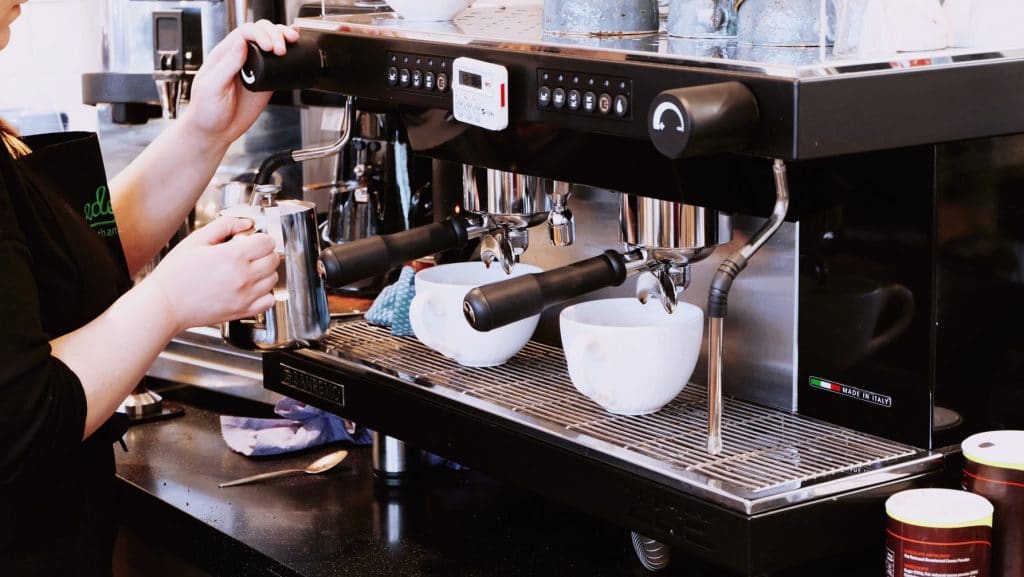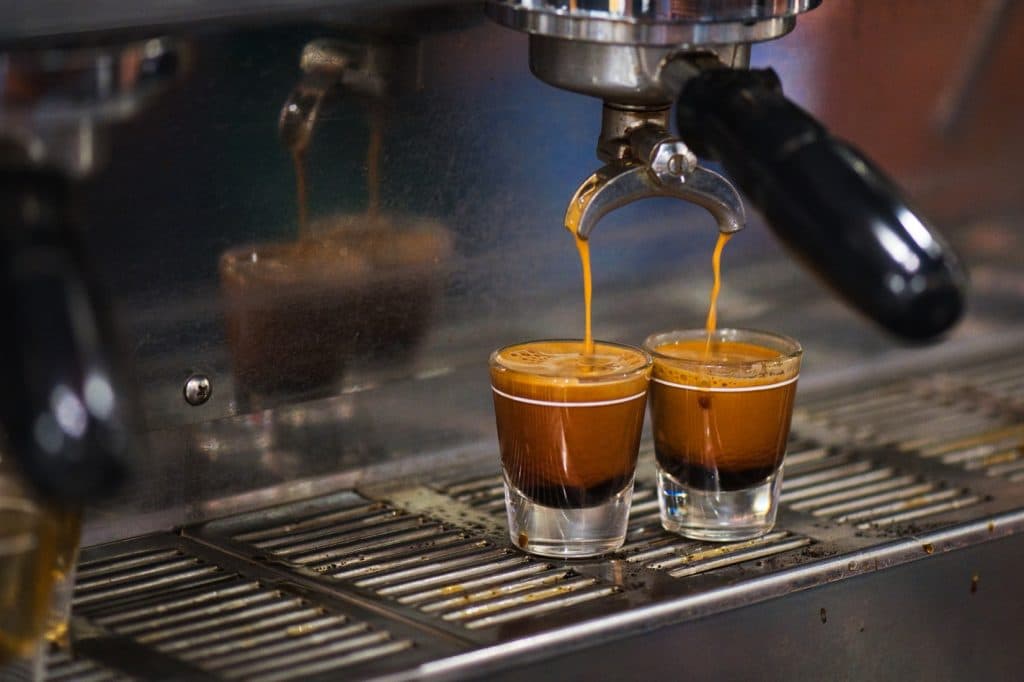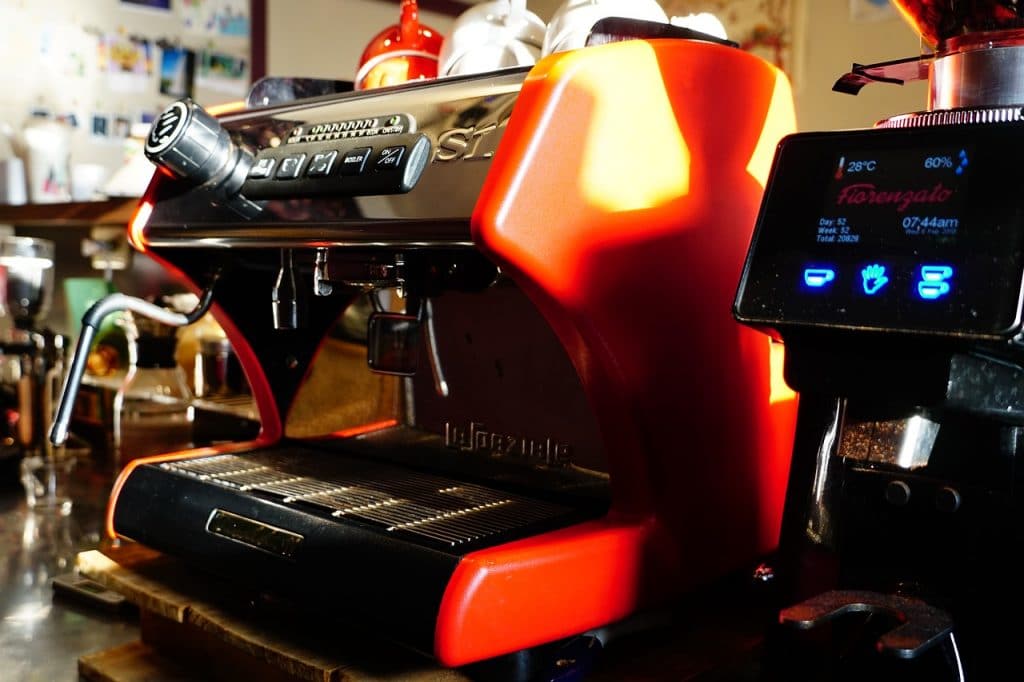When I was sitting in a cafe, I tried my first cup of good espresso, my joy knew no bounds! I truly fell in love with this drink.
After this experience, I wanted to brew the same espresso without leaving my home, and I began to search the Internet for fully-functional espresso machines. Honestly, I was surprised at their high prices! So I’ve decided to sort out this issue, and you know, it is very interesting.
Why are espresso machines so expensive? Let’s find out.
What is an espresso machine?

An espresso machine is a device for making an espresso coffee drink.
An espresso machine works by pushing hot water through a compact layer of ground coffee at high pressure. Many modern models are also equipped with a steamer.
History of espresso machines
After the invention of the espresso coffee machine by the Milanese engineer Luigi Bezzer on November 18, 1901, espresso began to mean “strong coffee, pressed under high pressure in special machines with a lever.” The first machine wasn’t completely automated: a man lowered a lever with his hand to exert the necessary pressure.
In 1903, the Italian industrialist Desiderio Pavoni acquired a license to produce Bezzera coffee machines. Other inventors followed his example. In the early 1920s, the tower-like Pavoni and Victoria Arduino coffee makers, decorated with ornaments, became a characteristic feature of Italian cafes. They contributed to the spread of espresso coffee culture in Europe and America.
Only in 1947 did Milan bartender and inventor Achille Gaggia began to produce semi-automatic coffee machines, where the desired pressure could be achieved with water. Such machines still account for 90% of the global coffee machine market.
In 1961, Faema began manufacturing coffee machines in which water was passed through coffee using an electric pump. This design is still used in modern coffee makers: an electric pump drives cold water through a heat exchanger placed in a boiler with hot water. The heated water then passes through coffee grounds. At the same time, milk is steamed.
Features of Espresso Machines That Affect the Price

Quality
The cost of the best espresso machines is quite high due to the use of high-quality materials such as stainless steel, metal, and brass. The highest-quality espresso machines are designed to ensure stable cooking temperatures.
Many manufacturers reduce the cost of their budget espresso machines by using lower-cost materials in the case, frame and interior parts.
Although materials such as the industrial plastics used for the frame will not affect the quality of the espresso, poor framing can become a durability problem.
Other factors, such as brass quality, can cause a sudden change in temperature, which negatively affects the espresso. If you want a quality espresso at a lower cost, you can choose a semi-automatic or manual espresso machine.
Digital display
The digital display on traditional espresso machines makes the process easier. Digital display machines have excellent temperature stability and are made of high-quality materials.
The display has useful functions, such as a delay before infusion, shot timers, on/off programming, water temperature adjustment, cleaning programs, filter placement tips, and equipment diagnostics.
Adjustable brewing temperature
Traditional espresso machines are made with a temperature regulator and a regulator for the boiler. For those who want more control over the brewing temperature in order to avoid temperature fluctuations, this function is for you.
Temperature adjustment – separate groups
Some coffee machines are made with advanced temperature control, which allows you to brew coffee across individual groups, thus creating multiple espressos at once from one machine. This is a great feature for those who want to fully control the brewing temperature, serve more than one coffee, or profile coffee.
Espresso machines with this function usually have a distinctive design, many barista controls, and a digital display, and are made of high-quality materials. With this feature, you will not have a large range in terms of cost.
Constant pressure and profiling
Speaking of espresso machines, not many of us may be familiar with the constant pressure and profiling. Functions are critical and add value to the machine. Conventional cheap espresso machines may or may not have these features.
But new, expensive models are equipped with this feature and allow the consumer to create their own pressure profiles.
Given these growing user requirements, espresso machines have become more expensive as they’ve been equipped with new technologies. With a sophisticated internal structure, both electronic and mechanical, the espresso coffee machine has taken quality espresso to the next level.
Research and development
Customers may not be aware of the fact that every espresso machine has undergone a lengthy process of research and development, which increases the product’s price. For this reason, some espresso machines are very expensive – they have gone through more research and development.
Brand name
Brands are of great importance to the value of the product. Some branded products have exclusivity affixed to the label, leading to ridiculously high prices.
So why are espresso machines so expensive?
The answer is very simple – espresso machines are used to demonstrate the character and taste of coffee beans. To do this, they must include proper equipment, pressure, pumps, and specifications.
As a rule, the more the espresso machine costs, the better the coffee you can make. Unfortunately, based on all the necessary details and installed functions, there are not many cheap machines that can do their job properly.
What Are The Different Types Of Espresso Machines?

Steam machines
In 1884, at an exhibition in Turin, Angelo Moriondo introduced “a new steam engine for economical and quick preparation of coffee drinks.” Thus, a method for preparing coffee under pressure was born.
Electric steam coffee machines are still in use. They are easy to handle and manage, affordable, and compact. How do they work?
In a sealed tank, water is brought to a boiling point and steam is formed. This creates pressure that pushes water through the reservoir into the coffee. This is similar to what happens inside a geyser coffee machine.
The disadvantage of steam machines is their low pressure of only 1–1.5 bars, while the ideal pressure for espresso is 9 bars.
In these machines, the water used to create steam is also used to make coffee. This means that the water almost boils when it reaches the beans, and this can lead to excessive extraction and spoil the taste of the coffee.
A steam coffee machine will be a good choice if you want to save some money and are not ready to bother learning how to make espresso like a barista. By experimenting with the size of the grind, you can find a way to make good coffee without re-extraction.
Lever machines
Lever mechanisms require physical strength to make coffee. There are two types of lever mechanisms: manual and spring.
The manual machine can be recognized by the horizontal position of its lever. When the lever is raised, pre-heated water is poured into the cooking chamber, where it interacts with the ground beans. The barista can control the duration of the pre-wetting process, the flow rate, and the pressure by pressing the lever.
On machines with a spring mechanism, the lever points up when the inner spring is loose. When the lever is pressed, the spring is compressed and it lifts the piston. This opens the cooking chamber for the intake of water. When the lever rises and the spring is decompressed, the piston pushes the water down and espresso is prepared.
Lever coffee machines require physical effort and an understanding of how to control variables. And such complete human control can lead to instability in taste.
Most lever coffee machines have only one boiler, and you have to rely on the fact that the water cools before interacting with the coffee. This can lead to instability in taste.
Pump espresso machines
Pump espresso machines have been around since the 1960s and dominate the market. During operation, the electric pump pushes hot water through the brewing chamber to create a cup of coffee. When using an electric pump, it is easy to achieve constant high pressure.
Today, there are three main categories of pump-action coffee machines: semi-automatic, automatic and super-automatic. All of them differ in the type of pumps, the number of boilers, and the electronic controls.
Semi-automatic espresso machines
This is probably exactly what you imagine when you think about a professional espresso machine. Semi-automatic machines use an automated system to supply water to groups. Grinding, tamping, and control of the extraction time are the responsibility of the barista.
These machines are a good compromise between human control and mechanized use. You are responsible for the espresso, but the pressure and temperature of the water are regulated, so it’s difficult to ruin anything.
Automatic espresso machines
These are very similar to semi-automatic machines, but they independently stop the water supply. This ensures a constant volume in each serving of good espresso and means that you do not need to watch carefully every time to prevent overfilling. Automatic espresso machines are also used in coffee houses.
Super-automatic espresso machines
Super-automatic machines do everything themselves. The machine grinds and weighs the coffee, fills the portafilter, and tamps the ground coffee. Press the button and you get the same coffee every time. Some machines also allow you to adjust the size and time of grinding, but overall super-automatic machines don’t leave much room for creativity. Such coffee machines are usually used at home and in offices, but not in coffee houses.
FAQ
How much do espresso machines cost?
As often happens, this question is not easy to answer. It always depends on your needs and how you want to make espresso.
In general, quality, design, and materials play an important role in the cost of any coffee machine. The better these are, the more you need to pay.
If you need a simple espresso machine, then you can spend anywhere from 50 to 150 dollars depending on steaming possibilities, the size of the water tank, and other features. The most popular coffee machines cost between 150 and 300 dollars.
Is a home espresso machine worth it?
Yes, definitely. Here are a few of the benefits of buying an espresso machine for your home:
- Coffee machines with built-in coffee grinders brew grain coffee, which tastes different from instant coffee or coffee prepared in a conventional coffee maker. Many machines also allow you to choose the strength of the drink.
- Automated coffee machines are great for saving time. Brew coffee for 10 minutes every morning? That’s only an hour a week, 4 hours a month, 50 hours a year!
- The home machines can be very easy to use. In many cases, it is enough to pour in the right amount of beans or ground coffee, and you will enjoy an invigorating drink every morning.
- More advanced coffee machines can prepare several types of coffee drinks, which is convenient for a large family or when you have guests.
What is the most expensive espresso machine?
The most expensive espresso machine on Amazon is the Rancilio ZERO Pure Coffee Espresso Machine (from $ 23,000).
And the most expensive espresso machine in the world is the Javabot coffee machine, which costs approximately $1 million.
Is an expensive espresso machine worth it?
Yes, and here are a few reasons why:
- The coffee recipe can be changed. You can individually adjust the strength, volume, and temperature of drinks.
- You can create up to 8 user profiles. You can save recipes and start brewing with any combination of buttons on the touch screen.
- You don’t need to bother with maintenance. The machine will remind you about what it needs.
- The process of making coffee is quick – you touch a couple of sensors and everything is ready in one or two minutes. Remember how often you have to wait for a cup of coffee in a cafe? That won’t be a problem if you have a machine at home!
- Expensive coffee machines often have interesting features: they can be controlled by a smartphone, or have two containers for coffee beans so you can create your own blend.
Now that you know more about espresso machines and their cost, I hope you will choose one for your home. Let me know which one you chose in the comments!
